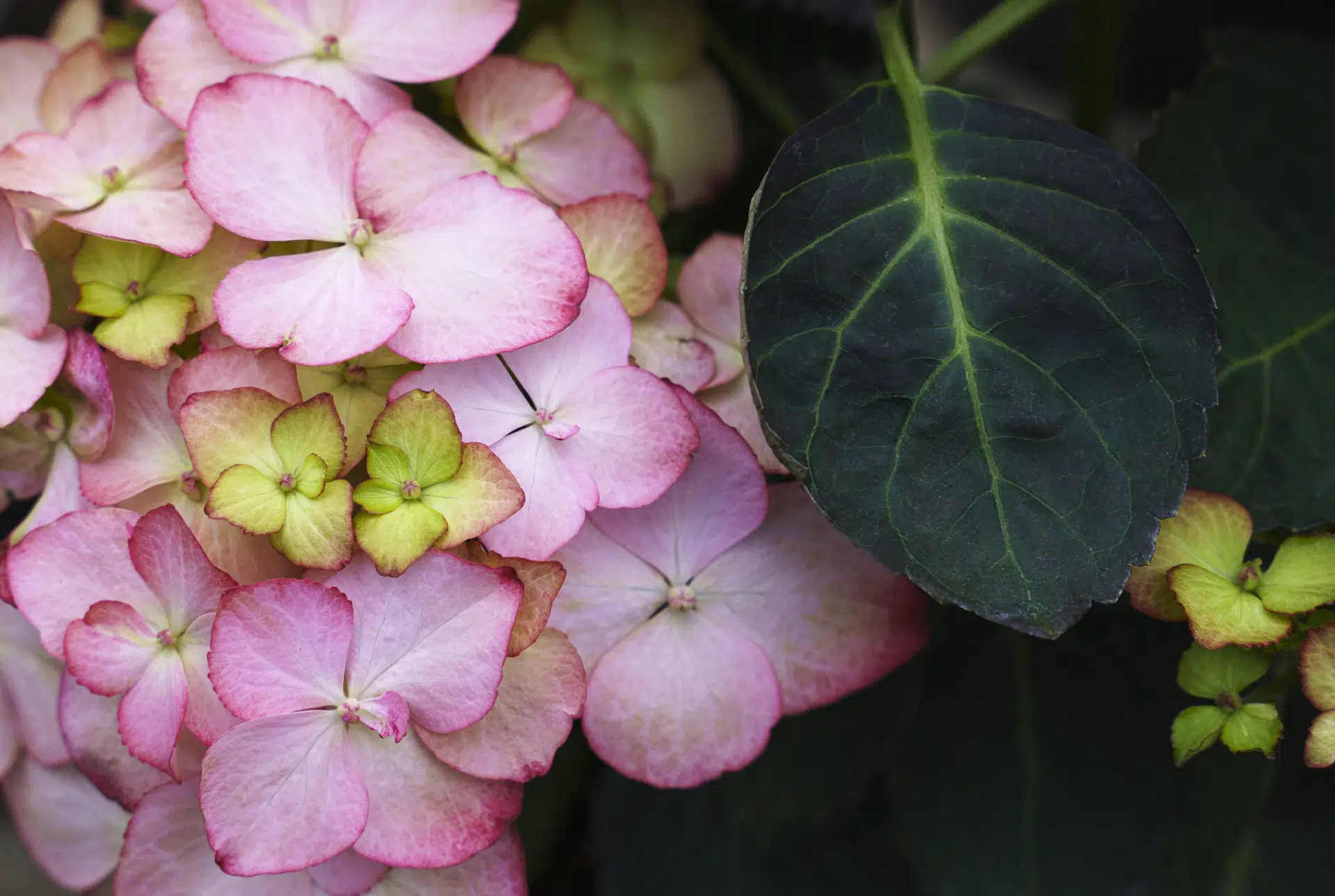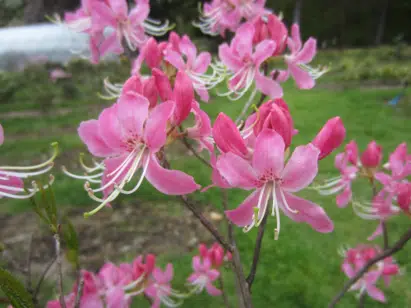Plants
Native

Looking for something in particular? Click here to search.

Rhododendron vaseyi ‘Spring Spangle’
Deciduous azalea ‘Spring Spangle’
This is a deciduous azalea that produces clusters of pink flowers in mid-spring and has wonderful red-purple fall color. Can take sun or shade. An excellent azalea for our area. Only... more

Rhododendron ‘Bowie’
Lepidote rhododendron
'Bowie’, pronounced like “buoy”, is an intraspecific hybrid, scaly-leaved rhododendron, meaning it is the result of crossing the Appalachian native Rhododendron minus with the Florida Panhandle endemic Rhododendron minus var. chapmanii. Flip the leaves over and you’ll see tiny scales across the surface. A good... more

Rhododendron austrinum
Deciduous azalea
Rhododendron austrinum, the Florida flame azalea, is a deciduous azalea that produces clusters of yellow to orange, sweetly fragrant flowers in May. Though native to the Florida Panhandle, southern Alabama, and southeastern Mississippi, Rhododendron austrinum has proven... more

Rhododendron arborescens x cumberlandense ‘Camp’s Red’ Cross #13-185
Deciduous azalea ‘Camp’s Red’ Cross
Most of David Leach’s azalea hybrids have the same pedigree: Rhododendron arborescens x cumberlandense. These are some of our favorite azaleas at the David G. Leach Research Station. In 2013 Dr. Stephen Krebs remade this cross and grew out... more

Polygonatum pubescens
Hairy Solomon’s seal
This Solomon’s seal prefers partial sun to medium shade, moist conditions, and organic soils. It is a wonderful spring blooming plant with white tubular flowers gracing arching stems. Flowers give way to large blue fruit... more

Polygonatum biflorum
Great Solomon’s seal
Great Solomon's Seal has long, arching stems that dangle cream-colored flowers in early spring. It spreads slowly by rhizomes in optimal conditions. Large purple seeds and golden leaves add interest in fall. Great Solomon's seal can grow in full sun if provided adequate... more

Phlox stolonifera 'Blue Ridge'
Creeping phlox
Creeping phlox is a spreading, mat-forming phlox which is native to wooded areas and stream banks. Loose clusters of fragrant bluish lavender flowers appear on upright, leafy stems which rise above the foliage mat in spring. The genus... more

Phlox divaricata 'May Breeze'
Woodland phlox
This plant feature oodles of white flowers in May that appear to float above narrow, pointed leaves which die back after blooming. In summer, new growth spreads along low stems and more rounded, dark green foliage appears. Plants will self-sow and create great drifts that blend well with other woodland native in... more

Phlox paniculata 'Laura'
Garden phlox
This garden phlox cultivar is easy to grow and purportedly mildew resistant, preferring full sun and moist, humus-rich soil. The dense flowers of phlox ‘Laura’ are deep lavender purple with a white eye and appear in later summer and will last until early fall. ... more

Meehania cordata
Creeping mint
Named for Philadelphia botanist, Thomas Meehan, creeping mint is a sturdy perennial groundcover and a great substitute for nonnative ground covers like Lamium or Ajuga. Meehania cordata has long, trailing stems run across the... more

Maianthemum stellatum
Star-flowered Solomon’s seal
Maianthemum stellatum is a creeping rhizomatous perennial that is native to moist woods, slopes, prairies and meadows. Each stem is topped in May-June by a 2-3" long terminal raceme containing 6-15 white to greenish-white, 6-tepaled,... more

Lilium canadense
Canada lily
The flowers of this species are large orange-red trumpets that hang facing downward. There are one to five flowers at the top of the plant with petals that curve backward, but not as far... more

Bluntleaf waterleaf
Bluntleaf waterleaf
Hydrophyllum canadense is a low-growing, broad-leaved woodland perennial. Early foliage is dark green, mottled with silver, deeply lobed and very ornamental. As the growing season progresses, the leaves become solid green and maple-like, supported by bare stems... more

Geranium maculatum
Wild geranium
The flowers of wild geranium are borne above the leaves in groupings of two to ten lavender flowers. Each flower is one to two inches wide. Geranium comes from the... more

Dryopteris goldiana
Goldie’s wood fern
A deciduous fern, Goldie’s wood fern occurs in moist, rich soil in cool woods. Reaching a height of 3-5 feet, it is one of the largest Dryopteris in Ohio. The spores occur on the... more

Carex plantaginea
Seersucker sedge
Carex plantaginea is an attractive, clump forming woodland sedge that will perform well in partly shaded moist, humus-rich woods. It can tolerate difficult dry conditions once established. The leaves are broad and semi-evergreen with a striking lime green color and puckered surface and provide a nice textural aspect in a... more

Camassia scilloides
Wild hyacinth
This flood plain and moist prairie plant is a member of the lily family and is characterized by small bulbs, like those of a small tulip in size and shape. Light blue-violet flowers begin to bloom in late May and progress from the bottom toward... more

Asclepias incarnata 'Ice Ballet'
Swamp milkweed ‘Ice Ballet’
A white flowering version of swamp milkweed, it is easily grown in medium to wet soils in full sun but is also tolerant of average well-drained soils in cultivation. 'Ice Ballet' is a compact, white-flowered form... more

Arisaema dracontium
Green dragon
Arisaema dracontium is similar to Jack-in-the pulpit, except green dragon usually has only one large, compound leaf divided into 7-15 lance-shaped leaflets. In addition, the spadix is green and lacks the distinctive purple striping of Jack. ... more

Arisaema triphyllum
Jack-in-the-pulpit
Instead of the normal petal arrangement, the flowers of this family have an unusual form. The “jack” (spadix) is a 2-to-3-inch erect club which sits inside a green or purplish hood, the “pulpit” (spathe). ... more

Anemone canadensis
Canada anemone
This is a strong growing plant that needs room to move. White single flowers bloom from mid spring to early summer. This competitive plant is great for naturalizing a large area and will brighten up woodland edges... more

Hydrangea quercifolia
Oakleaf hydrangea
This outstanding shrub is native to the southeastern U.S. where it inhabits moist wooded slopes, ravines, and the banks of streams. Hydrangea quercifolia is one of two hydrangeas native to... more

Physocarpus opulifolius
Eastern ninebark
Eastern ninebark is easily grown in average, well-drained soil in full sun to part shade. It is an upright, somewhat coarse, deciduous shrub noted for its exfoliating bark which peels in... more

Cornus sericea ‘Ruby’
Red-osier dogwood
This cultivar was introduced in 1988 and was selected for its layering habit, bright red stems and uniform rounded form. Red stems provide some much need color in a snow-covered winter landscape. Small white flowers appear in the... more
People for Trees™
Make a difference in
your own backyard.
Plant and care for a tree beginning with making a pledge. We will support each pledge with easy-to-follow instructional toolkits, guidance on how to select the most appropriate tree and where to purchase it, free virtual classes and other ongoing support.
Make a pledgeWhat can we help you find?
Popular searches:




